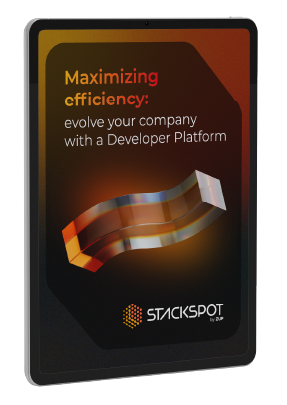Note: This blog post was created by the StackSpot Prompt Engineering team with the support of AI tools. This content underwent rigorous review for technical accuracy, content relevance, and well-written quality before its publication. Enjoy the read!
Platform Engineering has evolved in leaps and bounds, with changes so monumental it sometimes feels like comparing the Stone Age to the Silicon Age. As we stand amidst another revolution in practices in Platform Engineering, it’s immensely valuable to pause and reflect on our journey.
This reflection isn’t mere nostalgia; it’s about understanding the transformation and appreciating both the merits of our legacy and the present innovations.
The dawn of Platform Engineering: a more manual era
In the beginning of platform engineering, the world was different. It was an era of:
Physical Hardware Over Virtualization
Data centers were bustling with servers, each dedicated to a specific application. Provisioning was a lengthy process, sometimes taking weeks, contrasting sharply with today’s on-demand virtual instances that take mere seconds.
Monolithic Madness
Applications were monolithic, massive codebases that were cumbersome to maintain. Deployments were infrequent, often involving downtime, compared to today’s microservices architectures, allowing swift and seamless updates.
Limited Tooling
Back then, tools tailored for platform engineering were scarce. Every team had its own set of scripts and hacks to make things work, rather than the extensive tooling suites available today, from container orchestration to infrastructure as code.
Takeaway of past practices in Platform Engineering
However, this era of Practices in Platform Engineering had its merits. There was a deeper connection to the hardware. Engineers had a granular understanding of systems since they often had to handle everything from server provisioning to application health.
The modern age of practices in Platform Engineering: speed, scale, and automation
The shift to the modern age took time. It was a gradual process driven by scaling, efficiency, and agility demands. Here’s what defines the practices in Platform Engineering today:
Cloud-Native Cultures
The adoption of cloud services has been a game-changer. The ability to scale on-demand, combined with services for computing, storage, AI, and more, has enabled unprecedented agility and innovation.
Embracing Automation
Infrastructure as Code (IaC) and automation have become cornerstones. Everything can be automated, from provisioning resources to deploying applications, ensuring consistency and reducing human error.
Continuous Everything
Continuous Integration, Continuous Deployment, Continuous Testing – the emphasis on “continuous” processes has allowed rapid iterations, swift feedback loops, and improved software quality.
Microservices and Containers
Breaking applications into smaller, manageable services, often containerized, has allowed for faster deployments, better scalability, and isolation.
Takeaway of modern practices in Platform Engineering
Yet, with these advancements come fresh challenges. The complexity of systems has increased manifold. While we’ve automated numerous processes, the learning curve for mastering these tools and methodologies has grown steeper.
Consume innovation, begin transformation
Subscribe to our newsletter to stay updated on the latest best practices for leveraging technology to drive business impact
Lessons learned: bringing the best of both worlds
While it’s easy to get caught up in the “latest and greatest” practices, it’s vital to recognize the enduring principles that remain relevant:
The Importance of Fundamentals
No matter the era, a deep understanding of system fundamentals, from OS principles to networking basics, remains crucial. These basics provide the foundation upon which all other knowledge is built.
Human-Centric Approaches
Despite automation, the human element remains pivotal. Be it UX design, system reliability, or developer experience, systems must be designed keeping the end-user in mind.
The Need for Balance
While agility and speed are paramount, they shouldn’t come at the cost of quality or reliability. Striking a balance is critical, ensuring we remain stable and secure while moving fast.
Conclusion: The best practices in Platform Engineering are evolving with an eye on the past
As we stride into the future of practices in platform engineering, it’s imperative to carry forward the lessons of the past. The ability to combine the craftsmanship of yesteryears with today’s innovative practices will define our success.
The journey of platform engineering offers a valuable lesson: while tools, practices, and methodologies might change, the core principles of building robust, scalable, and user-centric platforms remain steadfast. And as we navigate the future, this blend of past wisdom and present innovation will be our guiding light.
Unlock the speed and security of developing with StackSpot!
As experienced software engineers, we understand that you seek to provide efficient and standardized solutions that allow your team to focus on solving business problems, not on assembling the necessary infrastructure to tackle these issues. We recognize that time is precious and efficiency is vital. That’s why we’ve developed StackSpot, our Enterprise Developer Platform designed specifically for professionals like you.
How about a hands-on test of StackSpot, completely adapted to your company’s unique context and challenges? Our goal is to demonstrate how our platform can simplify the distribution of guidelines and make their application easier, saving you time and boosting your team’s productivity.
Book a demo now! We’re eager to get to know you and your challenges. Let’s transform the landscape of your software engineering together with StackSpot.












